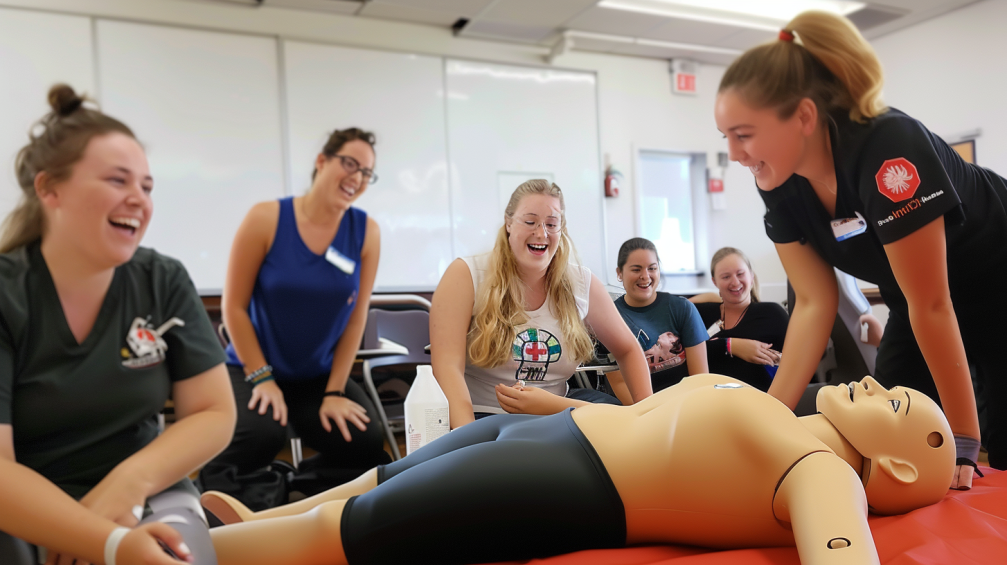Training and Assessment Delivered on Behalf of Allens Training Pty Ltd RTO 90909
Do First Aid Kits and Gear Go Out of Date? (Yes, here’s why)
Update 16/07/2024 We’ve completely overhauled this article from 2022 with a table of first aid kit expiry dates, info on first aid course expiry, an improved quality video and more info about specific workplace requirements. We think you’ll love it.
Ever glanced at that first aid kit tucked away in your cupboard or office drawer and wondered, “Does this thing ever go bad?” Well, you’re not alone, and I’ve got some news that might just shock you (don’t worry, not literally – we’re not talking about defibrillators here!).
First aid kits themselves don’t expire. But the stuff inside? First Aid Gear and Supplies do expire. The items in kit’s generally have a lifespan of 2-4 years from date of purchase.
And let me tell you, it’s a story worth knowing if you want to be the hero when an emergency strikes, rather than the person fumbling with ancient band-aids that stick to everything except the wound.
Expired First Aid Gear: What we found
Before we dive deeper, let me introduce you to our superstar team member, Abi. If you’re a fan of our TikTok account (and if you’re not, what are you waiting for?), you might have caught our eye-opening video series.
Picture this: Abi, armed with an assortment of expired first aid gear, demonstrating just how useless some of this stuff can become over time.
We’re talking triangular bandages that have mysteriously transformed into powder (talk about a magic trick gone wrong), band-aids that have lost their stickiness, and tape that refuses to do its one job – sticking to things.
The First Aid Expiration Explanation
So, why exactly do these life-saving supplies decide to retire before we’re ready to let them go? Here’s 3 important reasons.
Out of Date: Just Like That Milk in Your Fridge
Yes, folks, just like that carton of milk that’s been sitting in your fridge a bit too long, many first aid supplies come with their very own “best before” date. Antiseptic wipes, and eye wash solutions are all ticking time bombs of ineffectiveness.

Material Breakdown: When Your Supplies Decide to Decompose
Some first aid supplies, like our friend the adhesive bandage, are made of materials that break down over time. It’s like they hit middle age and decide to let themselves go. That Band-Aid you’ve been saving for a rainy day? It might just decide to fall off faster than a leaf in autumn when you finally need it.

Changing Guidelines: When First Aid Goes Through a Midlife Crisis
Believe it or not, the world of first aid is constantly evolving. What was best practice yesterday might be old news today. Remember when we all thought putting butter on a burn was a good idea? (Spoiler alert: it’s not!) Keeping up with these changes is crucial if you want to provide the best care possible.
The Expiry Life Lowdown
Now, let’s get down to the nitty-gritty. How long can you expect your first aid supplies to stick around before they decide to retire?
Band-Aids and Adhesive Products: These guys are the sprinters of the first aid world. With a shelf life of about 2-3 years, they’re quick to lose their stickiness. And let’s face it, a non-sticky sticking item is about as useful as a screen door on a submarine.
Antiseptic Sprays and Saline Solutions: These have a relatively short lifespan too, typically 2-3 years.
Crepe Bandages: While these don’t necessarily “expire,” they’re often single-use items. Once they’ve been wrapped around a sprained ankle or used to secure an ice pack, they’re ready for retirement.
Most Other Products: The good news is, many other items in your first aid kit can last 3-4 years, with some even pushing the 5-year mark.
Item Expiry Table
Please note that this is just a general guide and that many factors make up the exact expiry dates of items.
| First Aid Item | Average Expiry Timeframe |
|---|---|
| Band-Aids/Adhesive Bandages | 2 years |
| Antiseptic Wipes | 2-3 years |
| Antiseptic Sprays | 2-3 years |
| Saline Solution | 2-3 years |
| Crepe Bandages | 3-4 years, up to 5 years |
| Sterile Gauze Pads | 3-4 years |
| Adhesive Tape | 1-2 years |
| Pain Relief Medications | 1-3 years |
| Burn Ointments | 2-3 years |
| Eye Wash | 2-3 years |
| Scissors and Tweezers | Indefinite, if kept clean and dry |
| CPR Face Shield | 4-5 years |
| Thermometer | 3-4 years |
The Shipping and Stocking Caveat
Here’s something to keep in mind: that 5-year shelf life? It starts ticking from the moment the product is manufactured, not from when you buy it or when it arrives in your first aid kit. By the time it’s been shipped, stocked, sold, and finally makes its way into your eager hands, a good chunk of that lifespan might have already passed. It’s like buying a carton of eggs – always check the date!
Environmental Factors and the Lifespan of Kits

Now, let’s talk about where you keep your first aid kit. Is it basking in the sun on your boat? Enduring the sauna-like conditions of your car in summer? Or maybe it’s braving the elements in your outdoor work site? The environment plays a huge role in how quickly your supplies deteriorate.
Heat: That kit in your car? It’s basically going through a daily bake-off. Extreme temperatures can cause adhesives to melt, liquids to evaporate, and materials to degrade faster than you can say “ouch.”
Moisture: If your kit is exposed to damp conditions, you’re inviting mold and mildew to the party. And trust me, that’s one party you don’t want to attend.
Freezing Temperatures: On the flip side, extreme cold can cause liquids to freeze and expand, potentially damaging containers and altering the effectiveness of certain products.
The moral of the story? Treat your first aid kit like Goldilocks – find a spot that’s not too hot, not too cold, but just right. A cool, dry place away from direct sunlight is the five-star accommodation your first aid supplies deserve.
Workplace Kits: When Safety Meets Bureaucracy
Now, let’s talk about workplace first aid kits. In many countries, workplace health and safety regulations require regular checks and maintenance of first aid kits. In Australia, we have a document called the first aid code of practice. There’s usually one for each state and it provides advice on what you need to do for all things workplace first aid.
Here’s what it suggests:
So that’s AT LEAST EVERY 12 Months to meet Australian Standards.
Many businesses do more than the bare minimum of 12 months and check their kits multiple times a year. And honestly, can you blame them? Imagine needing a crucial supply in an emergency, only to find it was used months ago and never replaced. Talk about a workplace nightmare!

Many smart businesses opt for professional servicing of their first aid kits. (Hint, hint: that’s where we come in!) This ensures that everything is up to date, fully stocked, and ready for action at a moment’s notice.
Should I Replace Out of Date Equipment or the Whole First Aid Kit?
Here’s a common conundrum: You’ve got a first aid kit that’s seen better days. Some items are expired, others are running low, and you’re wondering if it’s time to just chuck the whole thing and start fresh. But hold your horses! Replacing an entire kit can be expensive and wasteful. Instead, consider the à la carte approach – replace items as they expire or get used up.
This method not only saves you money but also ensures that you’re always stocked with the freshest supplies. Plus, it’s a great opportunity to reassess your needs. Maybe you’ve realized you go through band-aids like they’re going out of style, or perhaps you’ve never once needed that triangular bandage. Tailoring your kit to your specific needs makes it more useful and cost-effective in the long run.
The Emergency Disclaimer: When Something is Better Than Nothing

Now, let’s address the elephant in the room. What if you’re in an emergency situation and all you’ve got is an expired first aid kit? First of all, don’t panic. In a pinch, an expired item is usually better than nothing at all. That said, this is definitely not an ideal situation, and it’s precisely why keeping your kit updated is so crucial.
If you find yourself in this predicament, use your best judgment. An expired adhesive bandage might not stick as well, but it can still cover a wound. Expired antiseptic might not be as potent, but it’s probably better than using nothing at all on a cut. Just remember, this is a last resort scenario – not your go-to plan.
First Aid Course Expiry
First Aid Courses: Your Life-Saving Skills Have an Expiry Date
Think your first aid certificate is a one-and-done deal? Think again. In Australia, your life-saving skills come with an expiry date, and it’s not just red tape. It’s about keeping you ready to act when it matters most.

Here’s the lowdown on when you need to refresh your skills:
- HLTAID009 Provide Cardiopulmonary Resuscitation: Renew every 12 months
- HLTAID011 Provide First Aid: Renew every 36 months
- HLTAID012 Provide First Aid in an Education and Care Setting: Renew every 36 months
Why the Refresh?
First Aid is Always Evolving. First aid techniques change faster than you might think. Here are a couple of examples that might surprise you: Tourniquets: Once a no-go, they’re now recommended for severe limb bleeding when direct pressure isn’t cutting it. Burn Treatment: Forget the old wives’ tale about butter on burns. These days, it’s all about cool running water for 20 minutes.
Hands-On Training: Where Theory Meets Practice
Reading about first aid is one thing, but hands-on training is where you really learn the ropes. Here’s why it matters:
- Muscle Memory: Your hands need to know what to do even when your brain’s in panic mode.
- Confidence Boost: Recent practice can make all the difference when you’re faced with a real emergency.
- Real-World Ready: Scenario-based training prepares you for the unpredictable nature of emergencies.

So, here’s the deal: if you’re not thinking about refreshing your first aid skills every year, you’re doing yourself (and potentially someone in need) a disservice. It’s like preparing for a marathon by watching running videos on YouTube – it might give you some ideas, but it won’t get you across the finish line.
Remember, in an emergency, you want to be the cool, calm, and collected hero who knows exactly what to do – not the panicked bystander frantically Googling “How to do CPR” on their phone. So keep those skills fresh, stay up to date, and be ready to save the day!
The Wrap-Up: Keeping Your First Aid Game Strong
So, there you have it – the lowdown on first aid kit expiration. Let’s recap the key points:
- First aid kits don’t expire, but their contents do.
- Different items have different shelf lives – know what’s what in your kit.
- Environmental factors can speed up deterioration, so store your kit wisely.
- Workplace kits often need regular professional checking – don’t skimp on safety!
- Replace items as they expire rather than tossing the whole kit.
- In an emergency, expired is better than nothing – but try not to let it come to that.
- Keep your first aid knowledge fresh with regular recertification.
So, why not take the hassle out of maintaining your first aid kit? Our professional servicing team can keep your kit in good condition, ensuring you’re always prepared for the unexpected. We’ll check those expiry dates, top up supplies, and make sure everything’s ship-shape.
And while we’re talking about being prepared, why not level up your life-saving skills with one of our first aid courses? It’s a small investment of time that could make a world of difference when it really counts. Plus, you’ll get hands-on experience with the latest techniques – no more relying on that vague memory from years ago!
Remember, when it comes to first aid, it’s always better to be the hero than let things slide. So, give us a call today and let’s get you kitted out and skilled up. Your future self (and maybe a grateful stranger) will thank you!
Stay safe out there, and remember – we’ve got your back when it comes to keeping your first aid game strong

